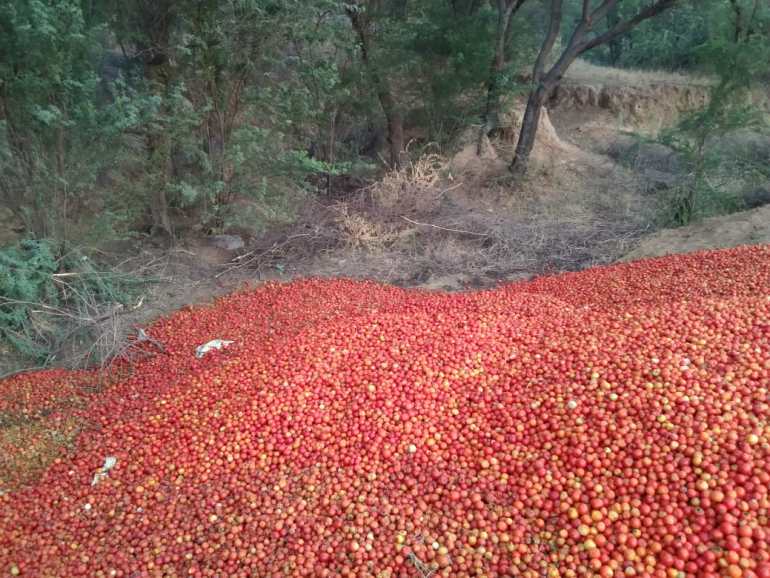“Tomato King” Ramesh Pangal, a farmer in the north Indian state of Haryana, had a good yield despite a heatwave that began earlier than usual this summer. By May, the tomatoes he had grown on 21 hectares (52 acres) after taking a loan of $22,000 were red, ripe and ready to be harvested.
The wholesale price of tomatoes had been depressed for the past eight months, but Pangal, who has won several awards and earned the grand “Tomato King” epithet for using technology to modernise farming in his region, was hoping the prices would stabilise.
They didn’t and after accounting for labour costs, all he got was 1.24 rupees (1 cent) per kilogramme, which didn’t cover his cost of production even.
By the middle of May, when farmers in the central Indian state of Maharashtra began dumping their yield on roads and in fields because the meagre 2-3 rupees [2.5-3.5 cents] per kilogramme they were being offered at the wholesale markets was not enough to cover even their cost of transporting the tomatoes, Pangal joined in.
“The irony is that when I started tomato cultivation in 2007 on about 100 acres, the wholesale price was around 4-5 rupees [4.9-6 cents]. Since then labour costs have gone up three-fold. The cost of transportation which was 60-70 paise [less than a cent] per kilogramme in 2007, is now 2-2.50 rupees [2.5-3 cents] per kilogramme. The bag of manure that I used to buy for 200 rupees [$2.43] now costs 1,350 rupees [$16.41]. But the wholesale price of tomatoes in May was 2-3 rupees [2.5-3.5 cents],” Pangal said.
For 10 days, starting May 25, he drove a tractor in his fields, turning almost half his standing crop of tomatoes into mulch.
Farmers across India either destroyed or abandoned their crops. What was left was wrecked by torrential rains in mid-June, leading to a sudden shortage of tomatoes, a staple in Indian kitchens. This pushed up prices and by July tomatoes were retailing for 200 rupees ($2.43) per kilogramme, even 250 rupees ($3.04) and more in some cities.
While this nearly 1,500 percent increase over a few weeks upset household budgets and restaurant menus, some farmers like Eshwar Gayakar in Maharashtra were experiencing a season of reward after years of debt and distress.
Gayakar, who incurred a loss of about $24,400 in 2021, told Al Jazeera that in April this year when he began planting tomatoes, the price in the wholesale market was 3 rupees (3.5 cents) per kilogramme. By June, the wholesale price had risen, first to 35 rupees (42 cents) per kilogramme and then shot up to 120 rupees ($1.46) in July.
“I sold my crop of tomatoes for $462,100 this year,” he said.
Around the same time, India’s central bank, the Reserve Bank of India, whose mandate is to keep inflation between 2 and 6 percent, expressed “concern” about the rising retail price of tomatoes. Food has the highest weightage, about 45 percent, in India’s Consumer Price Index, and tomato prices were threatening to upset the overall inflation figures.
The federal government intervened by procuring tomatoes from farmers and supplying them to consumers in some cities at a subsidised rate.
“When tomato prices went down and farmers were dumping truckloads, the government did not interfere. But when the price went up, they started buying tomatoes at a higher price and sold them at a subsidised price. So, if you had to interfere, interfere both times. Or leave it to the market and the market will find a solution,” said GV Ramanjaneyulu, an agricultural scientist with the Centre for Sustainable Agriculture.

Tomato prices have risen again. On Thursday, tomato was retailing at around 260 rupees ($3.15) a kg in Delhi and other cities.
The government has blamed the shortage and price rise on pest attacks and the weather. First the heat wave, then incessant rains and flooding, officials say, destroyed the crop and disrupted distribution.
Experts say this incomplete, skewed analysis is part of an old problem of selective interference to provide temporary quick fixes for a recurring problem that requires long-term planning.
“What is happening in this country is a common-sense problem. There’s summer and immediately after summer, there’s a shortfall. Before summer, you can actually store tomatoes. So how you address this is something one needs to look for. [But] unless you accept a problem, you will not find a solution,” Ramanjaneyulu said.
Food is political
Food in India is an emotive and political issue.
Rising onion prices have, since the 1980s, brought tears to the political campaigns of several stalwart leaders and led to shocking defeats in elections. So governments don’t take a chance with “TOP vegetables” – tomatoes, onions and potatoes, the three largest cultivated, produced and consumed vegetables in India – especially not around elections, which are due in several critical states in a few months.
Agriculture is the primary source of livelihood for about half of India’s 1.4 billion population, but its share of the gross domestic product (GDP) was 16.6 percent in 2022.
The loss to Indian farmers through the so-called “implicit taxation” – trade policies, government intervention and price control that’s biased towards the consumer – was a staggering $5,472bn between 2000 and 2016, reportedly said economist Ashok Gulati who based his math on an OECD-ICRIER report on the topic.
In 2016, two years before the report came out, Prime Minister Narendra Modi announced that his government would double the income of farmers by 2022, the year India celebrated 75 years of Independence. And during an election rally in 2018, he said, “Take T from tomato, O from Onion and P from Potato, you get TOP. Farmers are TOP priority for us.”
But some economists say that farm income has declined since then.
“Between 2016-17 and 2020-21, the last year for which data is available, farmers’ income has declined 1.5 percent per annum,” Himanshu, an associate professor of economics at Delhi’s Jawaharlal Nehru University, told Al Jazeera.

There are several government schemes for crop insurance, loans, and even direct income support for farmers. ‘Tomato King’ Pangal says each one has many caveats and few farmers are able to benefit from them.
One solution being bandied about is attaching a minimum support price to the more price-sensitive vegetables.
In India, the government offers this to 22 farm products, including wheat, rice and pulses. If the market price falls below the MSP – which is at least 1.5 times the cost of production, but is often less than the market price – the government buys the produce from the farmers. This guarantees income to the farmers and a surplus for exports.
In 2021-2022, India’s agriculture exports crossed $50bn for the first time, led by wheat, rice and sugar.
But MSP may not be a solution for tomatoes, which has a short shelf life when plucked and is a high-risk crop that is sensitive to weather changes. If the temperature reaches more than 25-30 degree Celsius, tomatoes don’t get their deep red colour. If there is too much rain, plants are deprived of oxygen and they begin to wilt and die.
During the summer, the temperature in most parts of India exceeds 40 degrees and the total production is very low. So historically, tomato prices shoot up in July, in comparison to lower prices in February-March.
“This tomato shortage in July has been known for the last 25 to 30 years. If that is the case, then that’s a potential business, right? Why hasn’t a single company come forward to address this problem? Because there’s fear that if I invest and bring some solution, suddenly the government will do something that will distort the whole market,” Ramanjaneyulu said.
The government, he says, has to invest in processing units and affordable cold storage facilities, especially with the increase in frequency and intensity of extreme weather conditions.
Changing rainfall pattern

In India, the number of days in a year when temperature rises beyond 33 degrees Celsius has gone up from 70 to 89 in the last three decades.
The pattern of rainfall during India’s monsoon, which usually lasts from June to September, has also changed.
“For 10 days, you get maximum rain. And for the rest of the days, you get minimal rain,” Ramanjaneyulu said.
This is adding to farmers’ distress.
Sunil Sinha, senior director and principal economist with India Ratings and Research, says that creating a cold storage chain, with storing facilities and refrigerated vehicles for transport, is not rocket science.
“It is a tried and tested technology that is available globally. But it requires a significant amount of investment that has to come from the private sector,” he told Al Jazeera.
But he says that there is a trust deficit.
“Farmers fear that private companies will create monopolies, exploit them and sell their produce at ‘super normal profits’. Corporates are scared … farmers won’t honour their contract, which will lead to long-drawn lawsuits,” he said.
Appointing a regulator to govern the functioning of the agriculture produce market, the same as the government did in insurance, real estate, stock market and power sectors, is one way to mitigate that distrust, Sinha said.
“A regulatory body will protect everyone’s interest and the scale will not tilt in favour of the consumer, producer, investor or the intermediary,” he said.
Another idea to ensure farmers get better prices while insulating consumers from sudden price shocks is for farmers to set up cooperatives and invest in creating their own cold storage chains, with government support, like what happened with milk in the early 1970s.
Verghese Kurien, then chairman of the National Dairy Development Board, led a movement to create a national milk grid, linking producers to consumers, thus reducing price variations and ensuring that producers got a major share of the profit. It also transformed India from a milk-deficient nation to become the world’s largest milk producer.
“Milk was a single commodity, so it’ll be a little complicated because of the many varieties of vegetables, but it’s doable,” Sinha said.
The Indian government seems to be moving in that direction. In July 2021, they created a Ministry of Cooperation to provide a legal, administrative and policy framework for strengthening the cooperative movement in the country. India’s home minister Amit Shah, who heads the ministry, has been pushing farmers to create collectives, or Farmer Producer Organisations (FPOs), to avail credit and other support.
But that’s a long-term solution which doesn’t address the daily distress of farmers and consumers which climate experts say is going to get worse.
August is expected to see a drop in rainfall.
“That will affect the crop again. Whatever survived now may not survive then,” Ramanjaneyulu said.
Bhaskar Goswami, an agriculture policy expert, told Al Jazeera that the “thing that runs through my mind every morning is whether I should buy two litres of diesel or one kilogramme of tomatoes.”
Sumber: www.aljazeera.com
 Skip to content
Skip to content

